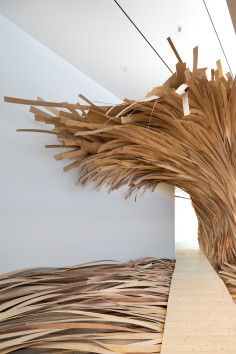WADE KAVANAUGH AND STEPHEN B NGUYEN
Hubris Ate Nemesis

source:dezeencom
Curvy and bent wooden strips are laid out to resemble a wave in this installation in Maine, created by local designers Wade Kavanaugh and Stephen B Nguyen.
Kavanaugh and Nguyen designed the Hubris Atë Nemesis installation for the Center for Maine Contemporary Art (CMCA), taking cues from the from the rough waters and wind in Maine.
Long, timber strips are layered across the floor and up the ceiling to fill the open-plan gallery space, with crests curling over entrances to other parts of the contemporary art gallery.
“The subject matter is borrowed from Maine’s rugged coastal landscape and the tradition of artists who have explored the interplay of its natural forces, people and built environment,” the designers told Dezeen.
Visitors can traverse over the wave-like design via a pair of wooden pathways that intersect in the middle of the space. They walkways are formed from boards that are arranged to gradually come apart.
“The path contributes to the experience of the work as a whole,” Kavanaugh and Nguyen said. “The viewer is made aware of the movement of the artwork through their own movement over the undulating boardwalk.”
“By unifying this relationship between the ‘path’ and the ‘piece,’ the viewer is completely immersed in the work, removing the layer of separation between art and viewer,” the designers added.
The cohesion of the all wooden Hubris Atë Nemesis causes the design, and the path that stretches across it, to fuse together as one experience.
Kavanaugh and Nguyen have worked together for more than a decade, specialising in work that experiments with materials. They were selected as the first recipients of the Center for Maine Contemporary Art’s fellowship award to create the installation.
These different elements fuse together in the installation itself, as a reference to the natural environment.
“Like many paintings of the Maine coast, we hope this work captures a moment of suspense in a dynamic system – a snapshot with an uncertain future – and that it appears to be unwritten what the restored natural order should or might become,” the designers said.
Hubris Atë Nemesis shares similarities with a wood-stripped cocoon designed by students from London’s Architectural Association in Dorset, England.
Other designs featuring an abundance of wood are a ribbon-like installation by Sebastian Cox and Laura Ellen Bacon, a climbing structure by Kengo Kuma in Paris, a hollow pathway design by Thilo Frank, woven hut within a Mumbai office and a rodded volume in Genoa evocative of sails.
Hubris Atë Nemesis is open to the public at the Center for Maine Contemporary Art (CMCA) in Rockland, Maine from 23 March to 16 June 2019.
.
.
.
.
.
.
.
source:designboomcom
maine-based artists wade kavanaugh & stephen b. nguyen have installed a large-scale immersive tidal wave made out of wood at the center for maine contemporary art. the massive installation takes up the entirety of the museum’s gallery and invites users to navigate the art piece through a path that sometimes crashes into the walls, contributing to the experience of the work as a whole. the duo, known for their paper installations, has taken a step away from this material and one into the world of wood.
‘this work is a departure for us in two ways,’ comment kavanaugh & stephen b. nguyen. ‘we began collaborating in 2005 and all of our previous works have been made of paper (this piece is made entirely of wood). second, it is the first time in one of our installations that the path through the piece has become an active element. our goal was to find a way to translate the visual language we have developed in paper to a new material, but the impact of incorporating the pathway into the work was a surprise.’
dubbed hubris, atë, nemesis, the installation draws inspiration from maine’s rugged coastal landscape and the tradition of artists who have explored the interplay of its natural forces, people and built environment. its name derives from greek tragedies where hubris, characterized as an arrogant confidence, transforms to atë, a ruinous folly or madness, then ultimately to nemesis, a force of retribution that resets the natural order.
‘the viewer is made aware of the movement of the artwork through their own movement over the undulating boardwalk,’ the duo continues. ‘by unifying this relationship between the “path” and the “piece,” the viewer is completely immersed in the work, removing the layer of separation between art and viewer.’
.
.
.
.
.
.
.
source:journaldudesignfr
Les designers locaux Kavanaugh et Nguyen ont conçu l’installation Hubris Atë Nemesis pour le Centre d’art contemporain du Maine (CMCA), en prenant exemple sur les eaux troubles et le vent de la région.
De longues bandes de bois courbé recouvrent le sol et le plafond pour occuper l’espace de la galerie à plan ouvert et pour ressembler à une vague. « Le sujet est emprunté au paysage côtier accidenté du Maine et à la tradition d’artistes qui ont exploré le jeu de ses forces naturelles, de son peuple et de son environnement bâti » expliquent les designers. Les visiteurs peuvent traverser l’installation en forme de vague via des sentiers en bois qui se croisent au milieu de l’espace. Les passerelles sont constituées de planches disposées pour se séparer progressivement.
Le chemin contribue à l’expérience du travail dans son ensemble. Le spectateur est informé du mouvement de l’œuvre par son propre mouvement sur la promenade ondulée. En unifiant cette relation entre le chemin et la pièce, le spectateur est complètement immergé dans l’installation, supprimant ainsi la couche de séparation entre l’art et le spectateur. Kavanaugh et Nguyen

